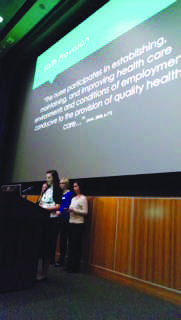Nursing students present capstone clinical experiences
Students brought classroom education into the work field

PRESENTATIONS: Nursing Capstone students present their evidence based on practice solutions to address real-life clinical issues on May 5 in Woodland Theater. Submitted
May 7, 2014
On May 5, nursing capstone students presented their clinical experiences from past semesters in evidence-based projects.
Students presented their projects in Woodland Theater in Davies Center, in front of nursing faculty, fellow nursing capstone students and community members.
Senior nursing major Marissa Tratz said the projects were based on “real-world problems” the class experienced during their clinical in acute care earlier this semester.
“To solve the problem, we had to make some sort of a product, present on it, and write a paper about it,” Tratz said.
The day started off with a welcome from professor of nursing, Arin VanWormer. Following the welcome, capstone students presented their projects and solutions throughout the entire day. There were 14 presentations throughout the day.
On capstone day, students were able to put what they learned in nursing school and real life experience into one project.
Senior nursing student Kristal Reszler and her group presented on nursing shift reports, focusing on disasters that have occurred with patient handoff, which is when a patient is passed from one nurse to another nurse.
The group researched and learned most facilities do not have standards for the switch. The group presented the problem, research and solutions for patient handoff.
“Through our clinical experiences we critically examined our environments and sought out to improve upon them,” Reszler said. “Capstone day is not just validation for our clinical work this semester, but rather validation of the work we did throughout nursing school.”
Students have been participating in clinicals since their first semester of nursing school, however, each semester has been different. The capstone semester is more intense because students take on full registered nurse responsibilities.
The group of Rebeccah Fleege, Denae Nygren, Jacquelyn Pearson and Leah Schultz presented their research on the National Institute of Health stroke scale.
Pearson started the group’s presentation by describing her first day of her clinical when she was asked to do a stroke test with the scale which she was unfamiliar with using. Each member of the group had similar experiences.
From there, each member went through and described the steps of the scale and how it differs from other coma scales. Each member of the group learned it differently and never saw it done the same way because each nurse did it his or her own way.
The group said they believe the NIH scale should be incorporated into the university’s curriculum, allowing students to understand it prior to working in the field.
Senior nursing major Erin Stone and her group chose to do their project on effective interpersonal communication. The group said they had personal experience in situations when communication among nurses or nurse-physicians was not very positive.
The group’s goal was to explore methods to improve communication.
“The purpose of our project was to provide tools for our peers to use to effectively communicate with colleagues of various professions,” Stone said.
Many of the nursing students said they thought their capstone experience differed from others both in their professional career and daily lives.
Senior nursing student Robert Knoll said he felt his self-confidence grow while putting what he learned in the classroom to work in the field.
“I think our capstone experience is unique,” Knoll said. “It’s an opportunity for us to show our faculty and community members what we’ve learned and how we are going to use that information to improve the quality of care we provide to our patients.”


